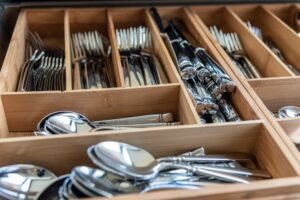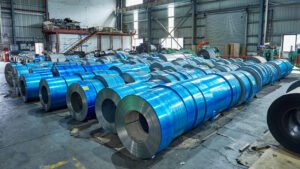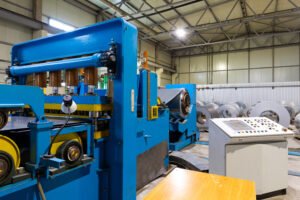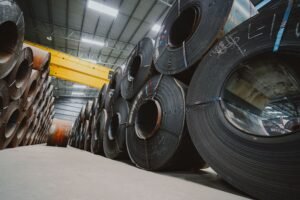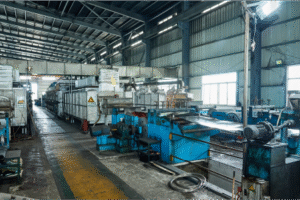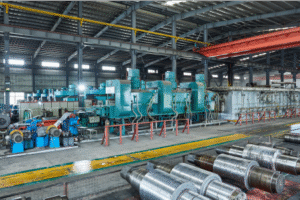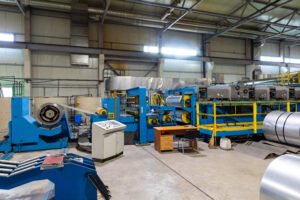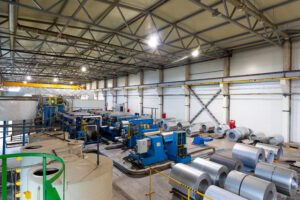How Is Bright Annealing Stainless Steel 430F/430FR Used in Magnetic Component Case Studies?
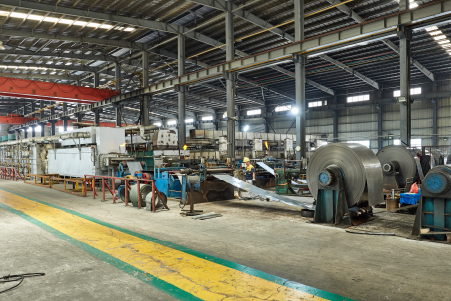
Struggling to achieve consistent magnetic performance in your stainless steel components? The issue often lies in post-machining heat treatment, where oxidation and internal stresses degrade material properties. You need a solution that preserves surface integrity while optimizing the steel's magnetic response for peak performance.
Bright annealing is a critical heat treatment process for 430F/430FR stainless steel that optimizes its use in magnetic components. It involves heating and cooling the metal in a controlled atmosphere, which prevents surface oxidation, relieves stress from manufacturing, and refines the metallurgical grain structure.
This refinement is essential for achieving the soft magnetic properties—like low coercivity and high magnetic permeability—that applications such as solenoid valves and sensors depend on. By understanding the nuances of this process, we can unlock the full potential of these specialized steel grades. In my years at AKS Furnace, I’ve seen firsthand how moving from a standard annealing process to a precision-controlled bright annealing environment transforms component reliability and performance for our clients.
At AKS, we've learned that a "good enough" approach to heat treatment is the enemy of high-performance manufacturing. The difference between a component that merely works and one that excels often comes down to the thermal process. This is especially true for ferritic stainless steels like 430F and 430FR, where magnetic properties are directly tied to the metallurgical structure. A poorly controlled anneal can leave residual stress or cause undesirable grain growth, leading to inconsistent magnetic fields and unpredictable actuation. Through countless client collaborations, we’ve demonstrated that investing in a precise, repeatable bright annealing process isn't a cost—it's a direct investment in product quality, energy efficiency, and market reputation.
What is the significance of bright annealing in stainless steel types 430F/430FR?
Are your 430F/430FR components suffering from surface oxidation and inconsistent magnetic behavior after heat treatment? The problem is a lack of atmospheric control. Bright annealing provides the solution by creating a pristine, stress-free metallurgical state, unlocking the material’s true potential for demanding applications.
The significance of bright annealing for 430F/430FR stainless steel lies in its ability to relieve internal stresses and refine grain structure in an oxygen-free atmosphere. This prevents surface scaling, preserves dimensions, and crucially, develops the optimal soft magnetic properties required for high-performance components.
When we talk about bright annealing, we're moving beyond simple heat treatment. We're discussing a highly controlled engineering process that directly impacts a component's final performance and reliability. For materials like 430F and 430FR, which are chosen specifically for their magnetic characteristics, this process is not optional; it's fundamental. A client of ours, a manufacturer of automotive solenoid valves, learned this the hard way. They were experiencing high rejection rates due to inconsistent valve response times. The issue wasn't the 430F material itself, but their conventional annealing process, which created a non-uniform microstructure and a thin oxide layer. By transitioning to one of our continuous bright annealing furnaces, they were able to eliminate these variables. The controlled hydrogen-nitrogen atmosphere prevented any surface oxidation, while the precise temperature and cooling cycle ensured every single part had the exact same stress-relieved grain structure. The result was a dramatic improvement in product consistency and a significant reduction in waste, directly impacting their bottom line. This illustrates that the "bright" in bright annealing refers not just to the shiny surface, but to a brighter performance outlook for the final product.
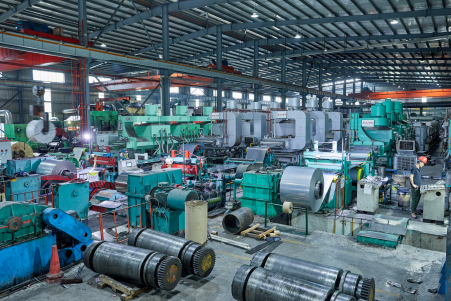
The true significance of bright annealing for these specific ferritic stainless steels is multifaceted, touching on surface quality, magnetic performance, and manufacturing efficiency. It’s a process where precise control yields tangible results that conventional methods simply cannot match. For engineers and manufacturers working with magnetic components, understanding these deep-level benefits is key to producing world-class products. We've seen companies transform their production capabilities by embracing the precision that this technology offers, moving from frustrating inconsistency to predictable excellence.
Preserving Surface Integrity and Eliminating Post-Processing
In the world of precision components, surface finish is not just about aesthetics; it's a functional requirement. For parts like solenoid plungers or sensor cores made from 430F/430FR, any surface imperfection can impede movement or affect magnetic flux. Traditional annealing in an open-air or endothermic gas furnace results in the formation of a dark oxide scale on the steel's surface. This scale must be removed through costly and often harsh secondary operations like pickling or abrasive blasting, which can alter the component's critical dimensions and introduce new surface stresses.
At AKS, we build our Печи для отжига Bright to eliminate this problem entirely. By using a protective atmosphere, typically a mix of hydrogen and nitrogen, we create an environment where oxidation cannot occur during the high-temperature cycle. A recent client producing components for electronic relays was struggling with high costs associated with their acid pickling line. After installing one of our continuous mesh belt furnaces, they were able to completely eliminate that post-processing step. The 430FR parts emerged from the furnace clean, bright, and ready for immediate assembly, cutting their production time by 20% and removing hazardous chemicals from their facility.
This illustrates a critical point: bright annealing is a proactive quality measure, not a reactive one. It prevents the problem of oxidation from ever occurring, rather than simply cleaning up the mess afterward. This approach leads to a more streamlined, cost-effective, and environmentally friendly manufacturing workflow, delivering a component that is superior in both form and function from the moment it leaves the furnace.
Optimizing Magnetic Properties Through Microstructural Control
The primary reason for selecting 430F or 430FR steel is for its soft magnetic properties: high permeability and low coercivity. However, these properties are not inherent; they are developed and optimized through proper heat treatment. The process of machining, stamping, or drawing components introduces significant internal stress and dislocations into the metal's crystal lattice. These imperfections act as pinning sites that impede the movement of magnetic domain walls, resulting in poor magnetic performance—specifically, higher coercivity and lower permeability.
Bright annealing serves the critical metallurgical function of stress relief and recrystallization. By heating the steel to a precise temperature (typically between 780°C and 850°C), we provide the thermal energy needed for atoms to rearrange themselves into a more stable, low-stress state. Our furnaces, with their multi-zone PID control systems, can maintain this temperature with a precision of ±1°C. This level of control is vital because overshooting the temperature can lead to excessive grain growth, which is detrimental to soft magnetic properties.
We worked with a manufacturer of fuel injector components who was facing inconsistent magnetic response. Analysis showed a wide variation in grain size in their parts. After implementing an AKS furnace with a tightly controlled heating and cooling profile, they achieved a uniform, fine-grained microstructure across every batch. This resulted in a 30% reduction in the standard deviation of magnetic coercivity, allowing them to meet the stringent specifications of their automotive clients and significantly enhance the reliability of their injectors. The controlled cooling cycle in our furnaces is just as important, as it locks in the optimized microstructure.
Achieving Process Repeatability for High-Volume Manufacturing
For manufacturers of magnetic components, especially in sectors like automotive or electronics, consistency is king. When you are producing thousands or millions of parts, each one must perform identically to the last. Batch-style annealing processes often struggle to deliver this level of uniformity. Temperature variations within the furnace and differences between cycles can lead to significant performance deviations from one batch to another.
This is where continuous bright annealing furnaces, like our Печи с сетчатой лентой, provide a decisive advantage. In a continuous furnace, each component travels along the belt and is exposed to the exact same temperature profile and atmospheric conditions for the exact same amount of time. This automated, consistent process eliminates the human error and inherent variability of batch operations, ensuring a level of process repeatability that is essential for statistical process control (SPC) and zero-defect manufacturing initiatives.
The table below contrasts the two approaches for a typical 430F solenoid core application, highlighting the clear advantages of a continuous process for achieving high-volume, high-quality production.
| Характеристика | Batch Annealing (e.g., Bogie Hearth) | Continuous Bright Annealing (Mesh Belt Furnace) |
|---|---|---|
| Process Consistency | Low to Medium; depends on loading & cycle | Very High; each part follows the same profile |
| Равномерность температуры | Variable; hot & cold spots are common | Excellent; multi-zone control ensures uniformity |
| Отделка поверхности | Requires post-processing (pickling/blasting) | Bright and clean; no secondary operations |
| Typical Rejection Rate | 5-10% due to inconsistency | <0.5% due to thermal process variability |
| Labor Requirement | High; requires manual loading/unloading | Low; process is highly automated |
| Энергоэффективность | Lower; furnace must be reheated each cycle | Higher; continuous operation & heat recovery |
A client producing electromagnetic clutches switched from a batch process to our continuous mesh belt system. Their primary goal was to improve consistency. Not only did their part-to-part magnetic property variation drop by over 80%, but our furnace's integrated Рекуперация отработанного тепла system also reduced their energy consumption per kilogram of steel by 25%, providing a powerful combination of quality improvement and operational cost savings.
Светлый отжиг предотвращает окисление поверхностиПравда
Bright annealing uses a controlled atmosphere to prevent oxygen from reacting with the steel surface during heat treatment.
430F steel is non-magneticЛожь
430F is specifically chosen for its soft magnetic properties, which are optimized through bright annealing.
How does the magnetic property of stainless steel 430F/430FR contribute to component performance?
Are your components failing to deliver the rapid, efficient actuation that your application demands? The raw material is only half the story. The soft magnetic properties of properly annealed 430F/430FR stainless steel1 are the key to unlocking the responsive performance that defines a high-quality product.
The soft magnetic properties of bright-annealed 430F/430FR, specifically its high magnetic permeability and low coercivity, are critical to component performance. They enable rapid magnetization and demagnetization, leading to faster response times, reduced energy loss, and highly repeatable actuation in devices like solenoids and sensors.
Delving into the magnetic properties of 430F/430FR steel takes us to the heart of why it's chosen for specific, demanding applications. It’s not just a piece of metal; it’s a functional material designed to manipulate magnetic fields. When we work with clients at AKS, our conversations often revolve around how to translate the theoretical potential of this material into tangible performance gains. For example, a customer in the fluid control industry wanted to develop a new, more efficient pneumatic valve. The success of their design hinged on the valve’s ability to open and close with extreme speed and minimal power consumption. The answer lay in maximizing the soft magnetic properties of the 430F actuator core. Through a series of tests in our R&D facility, we helped them define an optimal bright annealing cycle2. This process didn't just prevent oxidation; it engineered the material's magnetic domain structure to be as responsive as possible. The final product was a valve that not only outperformed its predecessor but also operated with 15% lower energy consumption, a direct result of harnessing the steel's magnetic characteristics through precise thermal processing.
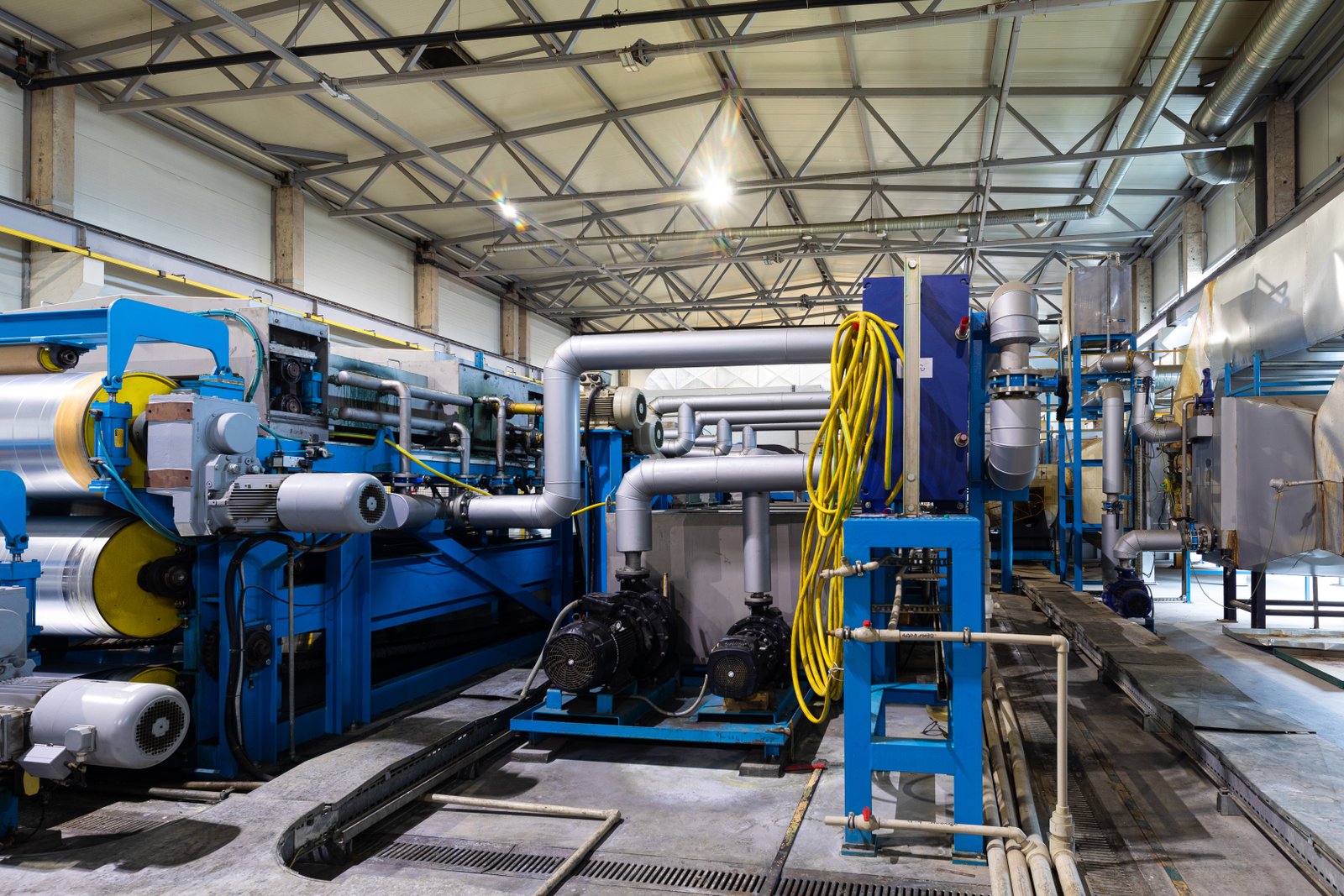
To truly appreciate the contribution of 430F/430FR, we must look at its specific magnetic characteristics and how they translate into mechanical work in real-world components. It’s a classic example of materials science directly enabling engineering innovation. The performance of a solenoid, relay, or sensor is not determined by its strongest possible magnetic pull, but by its ability to control that pull with speed and precision. This control is entirely dependent on the soft magnetic properties that are unlocked by processes like bright annealing, turning a simple steel component into the responsive heart of a complex system.
High Magnetic Permeability for Strong, Efficient Actuation
Magnetic permeability is a measure of a material's ability to support the formation of a magnetic field within itself. In simpler terms, it’s how easily a material can become a magnet. Ferritic stainless steels like 430F/430FR, when properly annealed, exhibit high magnetic permeability. For a component like a solenoid valve plunger, this is incredibly important. When an electric current flows through the surrounding coil, a material with high permeability will concentrate the magnetic flux lines, generating a much stronger magnetic field than air or a less permeable material would.
This translates directly into performance. A stronger magnetic field means a greater actuating force on the plunger for the same amount of electrical current. This allows engineers to design components that are either smaller and more compact while delivering the same force, or that operate with significantly lower power consumption. We had a client in the appliance industry manufacturing water inlet valves for washing machines. By optimizing the bright annealing process for their 430F valve cores in our Печь для отжига колокольного типа3, they were able to increase the magnetic permeability by 18%. This allowed them to reduce the copper wiring in their solenoid coils, leading to a direct cost saving of $0.15 per unit without sacrificing performance.
This efficiency is a cornerstone of modern engineering. In battery-powered devices or systems where energy efficiency is paramount, using a high-permeability core material is not a luxury but a necessity. The ability of bright annealing to create a stress-free, uniform grain structure is what allows the magnetic domains to align easily, maximizing this permeability effect and delivering a powerful competitive advantage.
Low Coercivity for Rapid Response and Minimal Energy Loss
If permeability is about how easily a material magnetizes, coercivity is about how easily it demagnetizes. It represents the amount of reverse magnetic field that must be applied to return the material to a zero-magnetization state after it has been saturated. For components that need to cycle on and off rapidly—think fuel injectors, high-frequency relays, or anti-lock braking system valves—low coercivity is arguably the most critical property. You want the component to actuate instantly when the power is on and release just as instantly when the power is off.
A material with high coercivity retains some of its magnetism (an effect known as remanence or residual magnetism), which can cause sluggish release or "sticking." This is disastrous for precision applications. Properly bright-annealed 430F/430FR has a very low coercive force. The heat treatment process minimizes the crystal lattice defects that can pin magnetic domain walls, allowing them to return to a random orientation the moment the external field is removed. This ensures a crisp, clean release and enables the high-speed cycling that modern systems demand.
Furthermore, coercivity is directly related to energy loss. The process of overcoming a material's coercivity to flip its magnetic state generates heat, an effect known as hysteresis loss. In a component cycling millions of times, this loss adds up, wasting energy and generating excess heat that can degrade the component and surrounding electronics. By minimizing coercivity through precise annealing in our Вакуумные печи для отжига4 for ultra-clean applications, we help our clients build components that are not only faster but also run cooler and more efficiently over their entire service life.
The Importance of Magnetic Saturation for Predictable Performance
Magnetic saturation is the point at which increasing the external magnetic field no longer increases the magnetization of a material. All the magnetic domains are already aligned. While you often want to operate below this point, the saturation value itself is an important design parameter. It defines the maximum force or magnetic pull a component can possibly generate. A high saturation flux density, which 430F/430FR possesses, means a higher performance ceiling.
For applications requiring strong holding forces, such as magnetic latches or certain types of actuators, operating near saturation is necessary. The key is consistency. The bright annealing process plays a vital role here by ensuring uniformity. In a poorly annealed part, residual stresses and non-uniform grain structure can cause certain regions of the component to saturate before others, leading to a "soft" saturation curve and unpredictable performance. This can be especially problematic in safety-critical applications.
We once consulted for a company making electromagnetic brakes for industrial machinery. Their 430F brake components were showing inconsistent engagement force. Our analysis revealed that their heat treatment process was creating a duplex microstructure with inconsistent grain sizes. By implementing a customized bright annealing cycle in one of our Печи для отжига с очагом Bogie5 designed for heavy components, we helped them achieve a homogenous, stress-free ferritic structure. The result was a much sharper, more predictable saturation curve and a 25% increase in the minimum guaranteed holding force of their brakes, significantly improving the safety and reliability of their product.
430F's high permeability increases solenoid forceПравда
Properly annealed 430F concentrates magnetic flux, creating stronger actuation force with the same electrical current.
Bright annealing only prevents oxidationЛожь
Bright annealing also optimizes magnetic domain structure for responsive performance, beyond just surface protection.
What challenges are typically faced in utilizing stainless steel 430F/430FR for magnetic components?
Have you selected 430F stainless steel for its magnetic properties only to face frustrating production hurdles? From difficult machining to unpredictable heat treatment results, these challenges can derail your project. Successfully navigating them requires a deep understanding of the material and its processing needs.
Key challenges in using 430F/430FR include managing its poor machinability and the impact of sulfur additions (in 430F) on magnetic purity. Furthermore, achieving the correct annealing parameters is critical, as improper heat treatment can fail to relieve stress or cause excessive grain growth, degrading magnetic performance.
While 430F and 430FR stainless steels are excellent choices for magnetic applications, they are not without their manufacturing complexities. As a furnace manufacturer, I've had countless conversations with engineers who are trying to solve the puzzle of this material. They know the performance they should be getting, but they are held back by practical challenges in their production line. A memorable case involved a producer of small, intricate parts for electromechanical counters. They were using 430F for its enhanced machinability, but the sulfur additions that helped with cutting were creating microscopic stringers, or inclusions, that disrupted magnetic field uniformity. Compounding the issue, their rudimentary annealing setup couldn't hold a tight enough temperature, resulting in parts that were either too hard or had poor magnetic response. It became clear that their challenges were twofold: material-related and process-related. Addressing these issues required a holistic approach, looking not just at the furnace but at the entire manufacturing journey of the component, from raw stock to final assembly. This is where a true partnership between the manufacturer and equipment supplier becomes invaluable.

The path to successfully manufacturing high-performance magnetic components from 430F/430FR is paved with specific technical challenges that must be proactively addressed. These are not materials you can simply machine and heat-treat with a generic process and expect optimal results. From the very first machining cut to the final cooling cycle, every step has an impact on the final magnetic properties. Overcoming these hurdles is what separates the average manufacturer from the industry leader, and it almost always comes down to a combination of material knowledge, process control, and the right capital equipment.
Balancing Machinability (430F) with Magnetic Purity (430FR)
One of the first decisions an engineer faces is whether to use grade 430F or 430FR. Grade 430F is the "free-machining" version, with sulfur intentionally added to its composition. The sulfur forms manganese sulfide inclusions, which act as chip breakers, significantly improving tool life and surface finish during turning, drilling, and milling operations. However, from a magnetic perspective, these sulfide inclusions are non-magnetic voids in the material. They create disruptions in the magnetic flux path, effectively reducing permeability and creating localized poles that can increase coercivity.
Grade 430FR, on the other hand, is a high-purity version with very low sulfur content. It offers superior magnetic properties but is significantly more difficult and costly to machine. The material is "gummy," leading to poor chip formation, rapid tool wear, and challenges in achieving a fine surface finish. The challenge, therefore, is a classic engineering trade-off: production cost versus magnetic performance. A manufacturer must decide if the enhanced machinability of 430F is worth the slight degradation in magnetic potential, or if the application demands the absolute best performance, justifying the higher machining cost of 430FR.
We often guide clients through this decision. For a high-volume, cost-sensitive solenoid valve, 430F combined with a perfectly optimized bright annealing cycle might be the most commercially viable solution. The annealing process helps to mitigate some of the negative effects of the inclusions by ensuring the surrounding metal matrix is perfectly stress-relieved. For a high-precision sensor in a scientific instrument, however, the purity of 430FR is non-negotiable, and the focus shifts to optimizing the machining and subsequent annealing processes to handle the more challenging material.
The Criticality of a Narrow Annealing Temperature Window
The single greatest process challenge with 430F/430FR is controlling the annealing temperature. The goal is to heat the material high enough to induce recrystallization and relieve all residual stress from cold working, but not so high as to cause excessive grain growth. For these grades, the ideal window is remarkably narrow. Below about 780°C, stress relief may be incomplete, leaving the component with high coercivity and poor magnetic response. Above approximately 850°C, a phenomenon called grain coarsening or grain growth begins to accelerate.
Large grains are highly detrimental to the soft magnetic properties of the steel. They lead to increased hysteresis loss and can make the material more brittle. Furthermore, in 430F, high temperatures can alter the morphology of the sulfide inclusions, making them more harmful to magnetic performance. This places an extreme demand on the furnace's temperature control system. A standard furnace with a temperature fluctuation of ±10°C or more is simply not capable of reliably hitting this narrow process window.
This is why the precision control systems on our AKS furnaces are so critical. Using advanced PID logic and multiple, strategically placed thermocouples, our systems can maintain the setpoint temperature across the entire heating zone with a uniformity of ±1°C to ±3°C. This precision ensures that every part, whether it's the first of the day or the last, receives the identical, optimal thermal treatment required to develop the desired fine-grained, stress-free microstructure for superior magnetic performance.
Preventing Contamination and Ensuring Atmospheric Purity
The "bright" in bright annealing is entirely dependent on the purity of the furnace atmosphere. 430-series stainless steels contain chromium, which provides corrosion resistance. However, chromium has a very high affinity for oxygen, especially at annealing temperatures. Even a few parts per million (PPM) of oxygen or water vapor in the furnace atmosphere can be enough to cause a light, passive oxide layer to form on the surface. While this layer might be invisible to the naked eye, it can be enough to interfere with subsequent processes like brazing or welding and can affect the component's magnetic surface properties.
The challenge is to maintain an extremely dry and oxygen-free atmosphere throughout the entire heating and, crucially, the cooling cycles. The furnace must be exceptionally well-sealed to prevent air ingress. The protective gas supply—typically a blend of nitrogen and hydrogen—must be of high purity and have a very low dew point (a measure of its moisture content). Hydrogen is particularly effective as it actively "scavenges" any trace oxygen, reacting with it to form water vapor that is then flushed from the system.
At AKS, we focus heavily on furnace integrity and atmosphere management. Our furnaces feature welded gas-tight shells, high-quality ceramic fiber insulation that doesn't outgas, and sophisticated atmosphere control panels that continuously monitor and regulate gas flow, pressure, and purity. Our advanced cooling sections are also designed to maintain atmospheric integrity until the parts are well below their oxidation temperature, ensuring they emerge with a truly bright, untarnished surface that is ready for the most demanding applications. This meticulous approach to atmospheric control is non-negotiable for achieving the highest quality results.
430F contains sulfur for machinabilityПравда
430F is intentionally alloyed with sulfur to improve machining characteristics, though this reduces magnetic purity.
Annealing above 850°C improves magnetic propertiesЛожь
Exceeding 850°C causes harmful grain growth that degrades magnetic performance in 430F/430FR steels.
How can engineering solutions optimize the use of stainless steel 430F/430FR stainless steel in magnetic applications?
Are you leaving performance and efficiency on the table by using a generic heat treatment process? To truly master 430F/430FR stainless steel, you need more than just a furnace. You need integrated engineering solutions that optimize every aspect of the thermal process for your specific application.
Engineering solutions optimize 430F/430FR steel by using custom-designed continuous bright annealing furnaces. These systems feature precise multi-zone temperature control, advanced atmospheric management, and integrated rapid cooling systems to ensure a uniform, stress-free microstructure, maximizing magnetic performance and dimensional stability for every component.
Moving from the challenges to the solutions requires a shift in thinking—from simply buying a piece of equipment to implementing an engineered system. At AKS, this is the core of our philosophy. We don't just sell furnaces; we provide comprehensive thermal processing solutions. I recall working with a manufacturer of automotive sensor sleeves who were struggling with part distortion after annealing. Their old furnace had a rudimentary cooling system, causing uneven temperature drops that warped the thin-walled components, leading to high scrap rates. The solution wasn't just a new furnace, but an engineered cooling system. We designed a custom Усовершенствованная система охлаждения for their new mesh belt furnace. This system used precisely directed, high-velocity jets of the protective atmosphere to cool the parts rapidly but uniformly, completely eliminating the warping issue. This is a perfect example of how an engineering-led approach, which looks beyond just the heating chamber, can solve complex manufacturing problems and unlock significant improvements in quality and yield. It’s about creating a holistic process where every element is designed to work in concert.
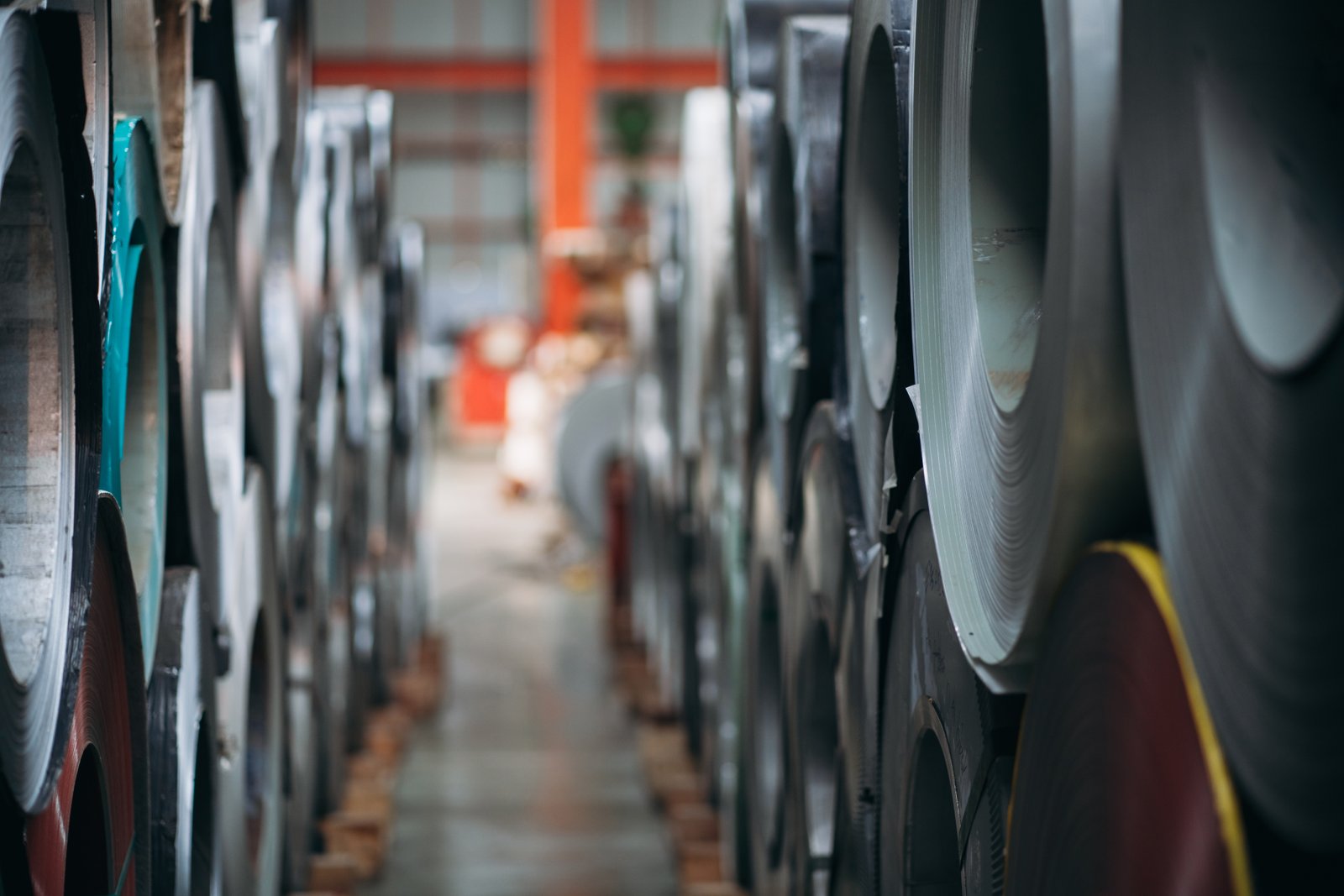
The optimization of 430F/430FR is not achieved by a single "magic bullet" but by the systematic application of advanced engineering principles across the entire heat treatment process. It involves tailoring the equipment and the process parameters to the specific geometry, material grade, and performance requirements of the component. This synergy between the part and the process is where true competitive advantage is forged. As furnace designers and builders, our role is to provide our clients with the sophisticated tools and controls needed to execute this optimization flawlessly, turning the potential of this specialty steel into a reliable, mass-produced reality.
Custom-Tailored Furnace Design for Application Specificity
A one-size-fits-all approach to industrial furnaces is rarely optimal, especially for specialized materials like 430F/430FR. The geometry, mass, and production volume of the component should dictate the design of the furnace. For instance, small, lightweight components like sensor housings or relay armatures are best processed in a Печь с сетчатой лентой. The mesh belt ensures that parts are handled gently and move through the furnace individually, guaranteeing each one receives identical treatment. We can customize the belt width, speed range, and the length of the heating and cooling zones to precisely match the client's required throughput and thermal profile.
Conversely, for heavier or bulkier components, such as large solenoid bodies or parts that must be processed in specific orientations, a Печь для отжига с очагом Bogie might be more appropriate. In this case, engineering focuses on ensuring uniform heating and gas circulation around a large, static load. For coiled wire or strip material, a Печь для отжига колокольного типа or a continuous Печь для отжига for strip is the only logical choice. The engineering solution here involves sophisticated atmosphere management within the sealed inner cover and precise control over the heating and cooling of the massive coil to ensure uniform properties from the outer wraps to the core.
A client in the telecommunications industry needed to anneal long, thin 430FR rods without distortion. A standard mesh belt would not provide adequate support. Our engineering solution was to design a furnace with a specialized roller hearth transport system. The driven ceramic rollers supported the rods along their entire length, preventing sagging at high temperatures and ensuring they emerged perfectly straight. This level of application-specific design is crucial for optimizing the manufacturing process.
The Role of Advanced Cooling and Atmosphere Control
The cooling phase of the annealing cycle is just as critical as the heating phase, yet it is often overlooked. For 430F/430FR, the goal is to cool the parts as quickly as possible without introducing new stresses or causing distortion. Rapid cooling helps to "lock in" the fine-grained microstructure achieved during annealing. Our Усовершенствованная система охлаждения is an engineering solution designed to do just that. It's a departure from simple water-jacketed cooling chambers. Instead, it functions as a heat exchanger, using the protective furnace atmosphere as the cooling medium.
This system draws the hot, clean atmosphere from the furnace, passes it through an external water-cooled heat exchanger, and then injects the resulting cold, dense gas back into the cooling chamber at high velocity. The flow can be precisely directed and modulated to provide aggressive yet uniform cooling. This is essential for maintaining the flatness of strip steel or the dimensional tolerances of complex machined parts. For one of our clients producing stainless steel foil, this system allowed them to increase their line speed by 30% while simultaneously improving the foil's flatness, a direct result of superior cooling control.
This is coupled with sophisticated atmosphere control. Our systems use zirconia probes and dew point sensors to continuously monitor the furnace atmosphere in real-time. This data feeds back to a PLC that automatically adjusts the flow of nitrogen, hydrogen, and dissociated ammonia to maintain the desired purity and pressure. This closed-loop control removes guesswork and guarantees the perfect bright annealing environment, cycle after cycle.
Integrating Automation and Data Logging for Process Validation
In modern manufacturing, especially in sectors like automotive and medical devices, process validation is non-negotiable. You must be able to prove that every single part was manufactured according to specification. A key engineering solution we provide at AKS is the full integration of automation and data logging into our furnace systems. This transforms the furnace from a simple heating tool into an intelligent, self-monitoring production asset.
Our control systems can log every critical process parameter for every batch or, in a continuous furnace, on a time-stamped basis. This data includes the temperature in each zone, belt speed or residence time, gas flow rates, atmospheric pressure, and dew point. This information can be archived to provide full traceability for quality audits. If a problem ever arises with a component in the field, the manufacturer can go back to the log and verify the exact conditions under which it was annealed.
Furthermore, this integration enables advanced automation. The system can automatically reject parts if any process parameter deviates from the setpoint, preventing a bad batch from ever reaching the customer. It can also provide predictive maintenance alerts, signaling when a thermocouple is drifting or a heating element is nearing the end of its life. For a major automotive supplier, we integrated one of our furnace control systems directly with their factory's Manufacturing Execution System (MES). This allowed for seamless recipe management, automatic data collection, and provided management with a real-time dashboard of their entire heat treatment operation, empowering them with the data needed to continuously optimize for quality and efficiency.
Custom furnaces optimize 430F/430FRПравда
The article explains how application-specific furnace designs (mesh belt, bogie hearth, bell-type) with tailored cooling systems maximize magnetic performance for different component geometries.
Cooling phase is less criticalЛожь
Advanced cooling systems are explicitly described as equally critical to heating for achieving stress-free microstructures and dimensional stability in 430F/430FR components.
What lessons have been learned from case studies involving stainless steel 430F/430FR?
Are you poised to repeat the same costly mistakes others have made with 430F/430FR steel? Real-world experience is a powerful teacher. The lessons learned from countless case studies provide a clear roadmap for success, helping you avoid common pitfalls in material selection and processing.
Case studies teach that successful use of 430F/430FR steel hinges on a holistic approach. It requires matching the material grade to the application's true needs, recognizing that the bright annealing process is as critical as the material itself, and fostering a collaborative partnership with equipment experts.
Over my career at AKS, I’ve seen numerous projects involving 430F and 430FR stainless steel. If there’s one overarching lesson, it’s that theory and practice can be two very different things. A data sheet can tell you a material’s potential, but only real-world application reveals the practical challenges of achieving that potential on a production floor. We once had a client, a very capable machine shop, who decided to expand into producing magnetic components. They bought 430F rods, machined beautiful parts, and then sent them out for heat treatment. The parts came back looking clean, but their performance was wildly inconsistent. They were on the verge of abandoning the project, blaming the material. This is a classic scenario. The lesson they learned, and one we see time and time again, is that you cannot decouple the material from its processing. The heat treatment isn't just a final step; it is an integral part of creating the final material properties. Their journey to success began only when they started viewing bright annealing as a critical manufacturing step6 they needed to control, not just a service to be outsourced.
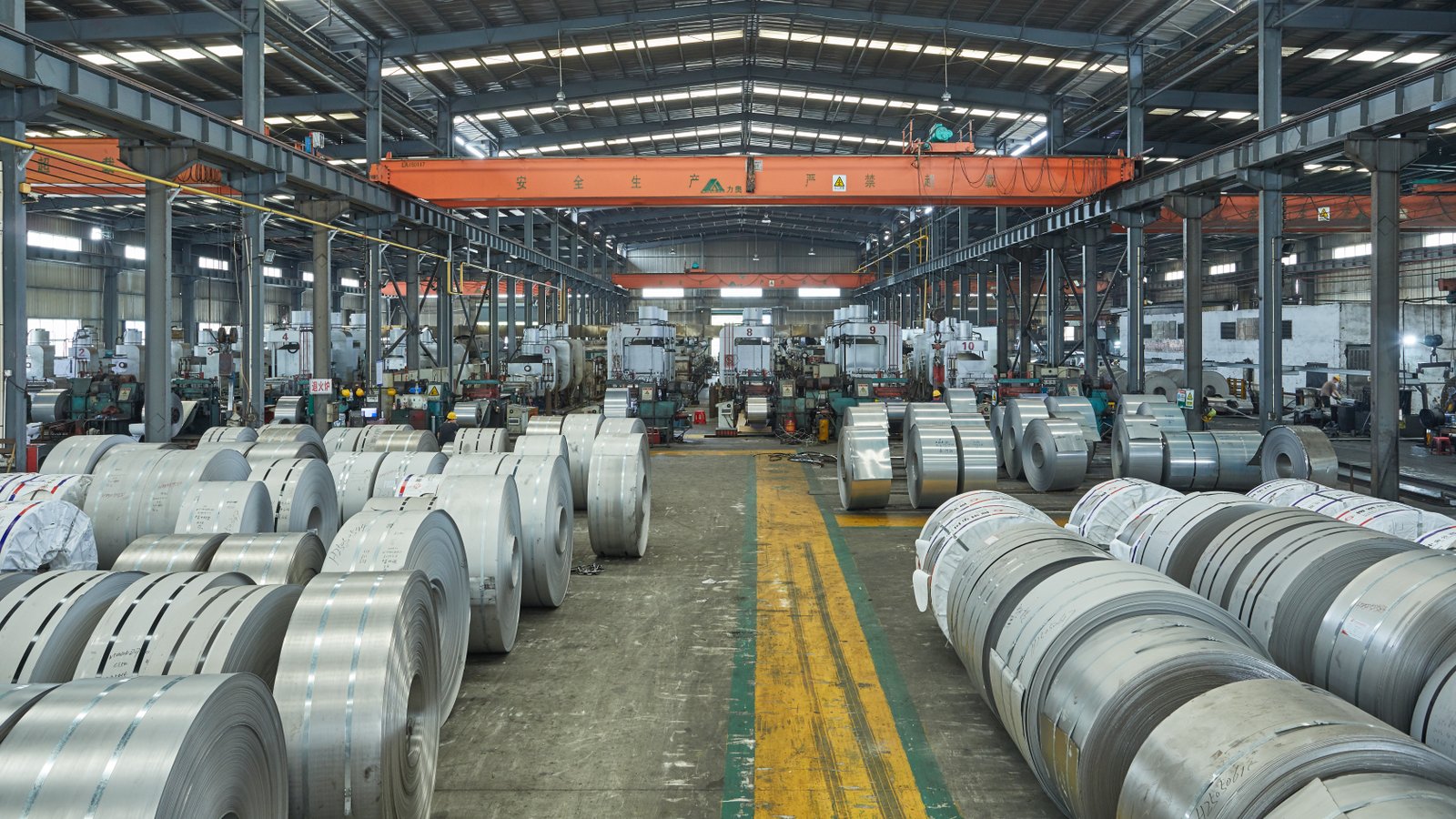
Reflecting on the vast library of client experiences and case studies is fundamental to our growth and innovation at AKS. These stories are more than just anecdotes; they are data points that reveal patterns of success and failure. They consistently show that excellence in manufacturing 430F/430FR components is not about finding a single secret but about mastering the entire process chain. The lessons learned are not just technical but also strategic, emphasizing the importance of diligence, control, and collaboration. They serve as a guide for new and existing manufacturers, helping them to shorten their learning curve and achieve high-quality results more quickly and efficiently.
Lesson 1: The Process Defines the Property
The most fundamental lesson learned is that the final magnetic properties of a 430F/430FR component are created in the furnace, not just selected from a materials catalog. Many engineers new to this material assume that by specifying "430F," they are guaranteeing a certain level of magnetic performance. In reality, a machined 430F part in its as-worked state has terrible magnetic properties due to the immense internal stresses. It is merely a component with the potential to be a good magnetic core.
A case study that perfectly illustrates this involved a manufacturer of anti-lock braking system (ABS) sensors. They meticulously controlled their machining process but used an old, general-purpose furnace for annealing. Their sensor outputs varied by as much as 15%, causing them to fail quality control. They brought us some parts for analysis. We could see from the microstructure that the annealing was incomplete and non-uniform. We re-annealed a batch of their machined parts7 in one of our lab's Vacuum Annealing Furnaces under a precise, validated cycle.
The result was a dramatic tightening of performance; the output variation dropped to under 2%. The lesson was crystal clear: the material was fine, the machining was fine, but their process was failing to transform the potential into reality. They learned that the bright annealing furnace is not just a heater; it is a machine for manufacturing metallurgical properties. Investing in a furnace with precise temperature and atmosphere control gave them direct control over the quality and performance of their final product.
Lesson 2: "Visually Bright" is Not "Metallurgically Correct"
A common and dangerous pitfall is judging the success of an annealing cycle by appearance alone. A component can emerge from a furnace with a bright, shiny surface but still be metallurgically flawed for its intended magnetic application. This creates a false sense of security and can lead to mysterious field failures down the line. A bright surface simply means the furnace had a reasonably oxygen-free atmosphere, but it says nothing about whether the core temperature was correct, the soak time was sufficient, or if grain growth has occurred.
We worked with a client producing electromagnetic clutches who had this exact issue. Their parts looked perfect, but under load, the clutch engagement was inconsistent. They proudly showed us their bright annealed parts from a competitor's furnace. Our lab analysis, however, told a different story. While the surface was clean, a cross-section revealed an excessively large grain structure. Their furnace, while good at keeping oxygen out, had poor temperature uniformity, causing parts to overheat, leading to grain growth and poor magnetic performance.
The lesson here is the importance of validation beyond visual inspection. We helped them establish a QA protocol that included not just visual checks but also sample-based Rockwell hardness testing and, critically, magnetic coercivity measurements using a hysteresigraph. True process control means verifying the properties that actually matter for the application. A high-quality bright annealing furnace, like those we build at AKS, provides the process stability that makes these metallurgical properties repeatable and predictable, so you can trust that a visually perfect part is also a functionally perfect one.
Lesson 3: The Value of a Holistic, Collaborative Approach
The final, and perhaps most important, lesson is that achieving optimal results rarely happens in a vacuum. The most successful projects we have been a part of are those built on a foundation of collaboration. The component manufacturer brings deep knowledge of their part's function and requirements. We, as the furnace experts, bring deep knowledge of thermal processing and material science. When these two areas of expertise are combined, a truly optimized solution can be developed.
Consider the case of the automotive solenoid valve manufacturer we mentioned earlier. They didn't just come to us to buy a furnace. They came to us with a problem: inconsistent valve response times. Our collaboration started long before a purchase order was signed. Our engineers worked with their team to analyze their entire process. We reviewed their material choice (430F), their stamping process, and their pre-anneal cleaning procedures. We ran trials on their parts in our own facility to develop a custom annealing recipe. The furnace we ultimately delivered was part of a complete, co-developed solution.
This holistic approach ensures that the furnace is not just dropped into a flawed process. Instead, the entire manufacturing workflow is optimized to work in concert with the new equipment. The lesson is that manufacturers should look for more than just a vendor; they should seek a technical partner. This partnership approach de-risks the investment, accelerates the time to high-quality production, and ensures that the full potential of both the material and the equipment is realized.
Bright annealing creates final propertiesПравда
The case studies show that bright annealing is critical for achieving the desired magnetic properties in 430F/430FR components, not just a cosmetic process.
Visual inspection guarantees qualityЛожь
The article demonstrates that parts can appear bright and shiny while still having metallurgical flaws that affect magnetic performance.
Заключение
Ultimately, transforming 430F/430FR steel into high-performance magnetic components is a science of control. Case studies consistently show that success depends on a precisely controlled bright annealing cycle, using engineered solutions to achieve the ideal microstructure. The furnace is where performance is truly defined.
-
Learn about the magnetic benefits that improve component performance in 430F/430FR stainless steel. ↩
-
Understand the impact of bright annealing on magnetic domain structure of stainless steel. ↩
-
Discover why Bell-Type Annealing Furnaces are optimal for improving magnetic permeability. ↩
-
Explore the role of Vacuum Annealing Furnaces in reducing energy loss and heat in stainless steel. ↩
-
Learn how Bogie Hearth Furnaces enhance safety and reliability in annealed stainless steel components. ↩
-
Discover how bright annealing enhances material properties crucial for manufacturing processes ↩
-
Understand the impact of vacuum annealing on the consistency and quality of magnetic properties in steel components ↩
У вас есть вопросы или нужна дополнительная информация?
Свяжитесь с нами, чтобы получить индивидуальную помощь и квалифицированный совет.

